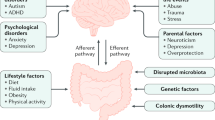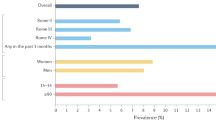Abstract
Chronic constipation is prevalent in Western countries and is a complaint that is commonly seen in clinical practice. Only a relatively small percentage of constipated patients seek medical evaluation and most can be managed satisfactorily with first-line, conservative therapy. In patients with severe, refractory constipation, additional studies of colonic and anorectal function have clinical utility, as such patients are candidates for therapies not given to most constipated patients. This article reviews the modern principles and therapies used to manage chronic constipation of varying severities.
Key Points
-
Chronic constipation can occur because of a primary motor disorder, in association with numerous diseases, or as a side effect of many drugs
-
A physical examination including neurologic examination and abdominal palpation should be performed before undertaking other diagnostic tests
-
A 2-week, prospectively obtained bowel diary and measurement of colonic transit time are the most useful diagnostic studies
-
First-line treatments include bulking agents, osmotic laxatives, stimulant laxatives, and enterokinetic agents
-
When first-line treatments fail, surgery, antegrade colonic enemas and behavioral approaches should be considered
This is a preview of subscription content, access via your institution
Access options
Subscribe to this journal
Receive 12 print issues and online access
$209.00 per year
only $17.42 per issue
Buy this article
- Purchase on Springer Link
- Instant access to full article PDF
Prices may be subject to local taxes which are calculated during checkout



Similar content being viewed by others
References
Thompson WG et al. (1999) Functional bowel disorders and functional abdominal pain. Gut 45 (Suppl 2): II43–II45
Higgins PDR and Johanson JF (2004) Epidemiology of constipation in North America: a systematic review. Am J Gastroenterol 99: 750–759
Locke GR et al. (2000) AGA technical review on constipation. American Gastroenterological Association. Gastroenterology 119: 1766–1778
Wald A (2005) Constipation and constipation syndromes. In Clinical Gastroenterology and Hepatology: The Modern Clinician's Guide, 443–451 (Eds WM Weinstein et al.) London: Elsevier Science
Muller-Lissner S et al. (2005) Myths and misconceptions about chronic constipation. Am J Gastroenterol 100: 232–242
Rao SS et al. (2004) Dyssynergic defecation: demographics, symptoms, stool patterns and quality of life. J Clin Gastroenterol 38: 680–685
Preston DM et al. (1985) Towards a radiologic definition of idiopathic megacolon. Gastrointest Radiol 10: 167–169
Rao SSC et al. (2005) Clinical utility of diagnostic tests for constipation in adults. Am J Gastroenterol 100: 1605–1615
Brandt LJ et al. (2005) Systematic review on the management of chronic constipation in North America. Am J Gastroenterol 100 (Suppl 1): S5–S21
Arhan P et al. (1981) Segmental colonic transit time. Dis Colon Rectum 24: 625–629
Metcalf AM et al. (1987) Simplified assessment of segmental colonic transit. Gastroenterology 92: 40–47
Minguiz M et al. (2004) Predictive value of the balloon expulsion test for excluding the diagnosis of pelvic floor dyssynergia in constipation. Gastroenterology 126: 57–62
Diamant NE et al. AGA technical review on anorectal testing techniques. Gastroenterology 116: 735–760
Wald A (2005) Severe constipation. Clin Gastroenterol Hepatol 3: 432–435
Corazziari E et al. (2000) Long-term efficacy, safety and tolerability of low daily doses of isosmotic polyethylene glycol balanced solution (PMF-100) in treatment of functional chronic constipation. Gut 46: 522–526
Johanson J et al. (2004) Effect of tegaserod in chronic constipation: a randomized, double-blind, controlled trial. Clin Gastroenterol Hepatol 2: 796–805
Kamm M et al. (2005) Tegaserod for the treatment of chronic constipation: a randomized, double-blind, placebo controlled multinational study. Am J Gastroenterol 100: 372–382
Roarty TP et al. (1997) Misoprostol in the treatment of chronic refractory constipation: results of a long-term open label trial. Aliment Pharmacol Ther 11: 1059–1066
Verne GN et al. (2003) Treatment of chronic constipation with colchicine: randomized, double-blind, placebo controlled crossover trial. Am J Gastroenterol 98: 1112–1116
Cheung O and Wald A (2004) Management of pelvic floor disorders. Aliment Pharmacol Ther 19: 481–495
Knowles CH et al. (1999) Outcome of colectomy for slow transit constipation. Ann Surg 230: 627–638
Gladman MA et al. (2005) Systematic review of surgical options for idiopathic megarectum and megacolon. Ann Surg 241: 562–574
O'Suilleabhain CB et al. (2001) Strategy for the surgical management of patients with idiopathic megarectum and megacolon. Br J Surg 88: 1392–1396
Heymen S et al. (2003) Biofeedback treatment of constipation: a critical review. Dis Colon Rectum 46: 1208–1217
Chiaroni G et al. (2005) Biofeedback benefits only patients with outlet dysfunction, not patients with isolated slow transit constipation. Gastroenterology 129: 86–97
Cleveland MV et al. (2001) New polyethylene glycol laxative for treatment of constipation in adults: a randomized, double-blind, placebo-controlled study. South Med J 94: 478–481
DiPalma JA et al. (2000) A randomized, placebo-controlled, multicenter study of the safety and efficacy of a new polyethylene glycol laxative. Am J Gastroenterol 95: 446–450
Corazziari E et al. (1996) Small volume isosmotic polyethylene glycol electrolyte balanced solution (PMF-100) in treatment of chronic nonorganic constipation. Dig Dis Sci 41: 1636–1642
Acknowledgements
The author thanks Helen Gibson for her expert preparation of the manuscript.
Author information
Authors and Affiliations
Corresponding author
Ethics declarations
Competing interests
The author is or has acted as a medical advisor to Novartis, GlaxoSmithKline, Boehringer-Ingelheim and Takeda Pharmaceuticals, and as a legal advisor to Schering-Plough and Novartis on matters pertaining to senna and biscodyl.
Rights and permissions
About this article
Cite this article
Wald, A. Pathophysiology, diagnosis and current management of chronic constipation. Nat Rev Gastroenterol Hepatol 3, 90–100 (2006). https://doi.org/10.1038/ncpgasthep0406
Received:
Accepted:
Issue Date:
DOI: https://doi.org/10.1038/ncpgasthep0406
This article is cited by
-
Chronic Constipation in the Elderly
American Journal of Gastroenterology (2012)
-
Efficient diagnosis of suspected functional bowel disorders
Nature Clinical Practice Gastroenterology & Hepatology (2008)
-
Intestinal Gas Retention in Patients with Idiopathic Slow-Transit Constipation
Digestive Diseases and Sciences (2007)



